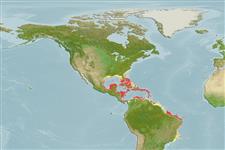>
Kurtiformes (Nurseryfishes, cardinalfishes.) >
Apogonidae (Cardinalfishes) > Apogoninae
Etymology: Apogon: Greek, a = without + Greek pogon = chin, beard (Ref. 45335).
Environment: milieu / climate zone / depth range / distribution range
Ecologia
marinhas associadas(os) a recifes; intervalo de profundidade 3 - 55 m (Ref. 9710). Tropical
Western Central Atlantic: southern Florida, USA and Bahamas, Caribbean, including Antilles (Ref. 26938) to northern South America.
Tamanho / Peso / Idade
Maturity: Lm ? range ? - ? cm
Max length : 6.5 cm SL macho/indeterminado; (Ref. 26938)
Inhabits coral and rocky areas, often near drop-offs. Solitary or in groups in caves or holes (Ref. 9710). Often seen hovering in the spines of long-spined urchin.
Ciclo de vida ou comportamento de acasalamento
Maturities | Reprodução | Spawnings | Egg(s) | Fecundities | Larvas
Mouthbrooders (Ref. 240). Distinct pairing during courtship and spawning (Ref. 205).
Robins, C.R. and G.C. Ray, 1986. A field guide to Atlantic coast fishes of North America. Houghton Mifflin Company, Boston, U.S.A. 354 p. (Ref. 7251)
Status na Lista Vermelha da UICN (Ref. 130435)
Ameaça para os humanos
Harmless
Uso pelos humanos
Ferramentas
Relatórios especiais
Baixar XML
Fontes da internet
Estimates based on models
Preferred temperature (Ref.
123201): 24.8 - 28, mean 27 °C (based on 236 cells).
Índice de diversidade filogenética (Ref.
82804): PD
50 = 0.5000 [Uniqueness, from 0.5 = low to 2.0 = high].
Bayesian length-weight: a=0.01072 (0.00473 - 0.02425), b=3.09 (2.92 - 3.26), in cm total length, based on LWR estimates for this Genus-body shape (Ref.
93245).
Nível Trófico (Ref.
69278): 3.4 ±0.5 se; based on size and trophs of closest relatives
Resiliência (Ref.
120179): Elevada, tempo mínimo de duplicação da população menor que 15 meses (Preliminary K or Fecundity.).
Fishing Vulnerability (Ref.
59153): Low vulnerability (10 of 100).
Nutrients (Ref.
124155): Calcium = 188 [108, 389] mg/100g; Iron = 1.24 [0.69, 2.07] mg/100g; Protein = 18.9 [17.7, 20.0] %; Omega3 = 0.186 [0.101, 0.347] g/100g; Selenium = 35.1 [16.3, 69.9] μg/100g; VitaminA = 92.7 [29.6, 283.8] μg/100g; Zinc = 2.46 [1.58, 3.56] mg/100g (wet weight);
